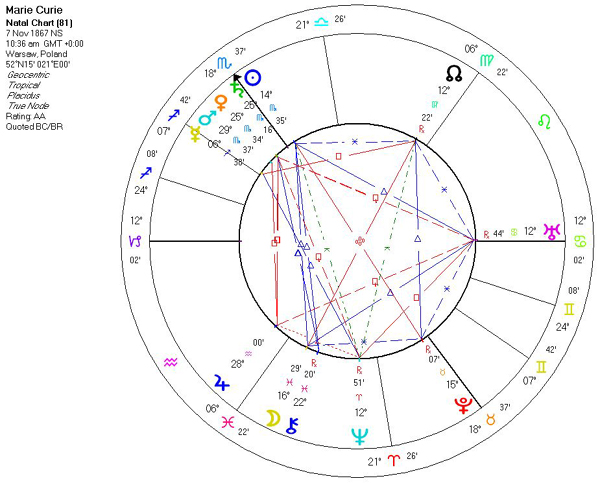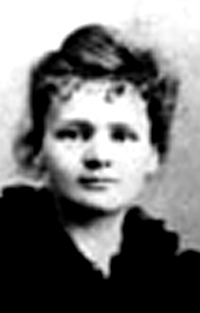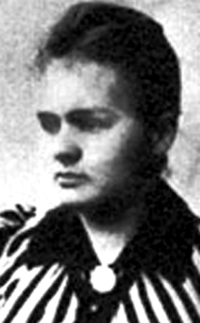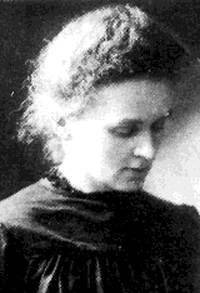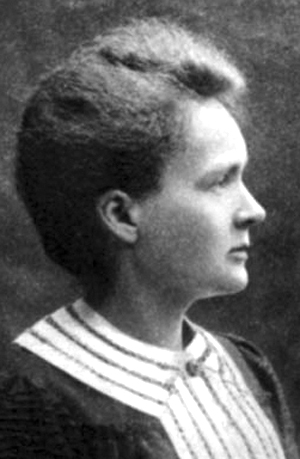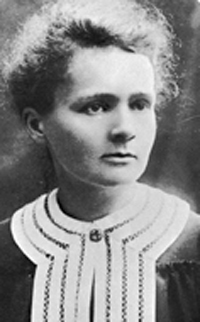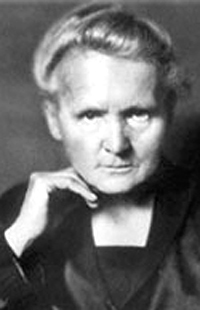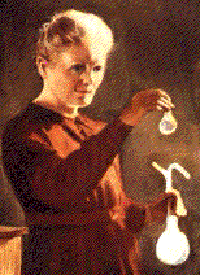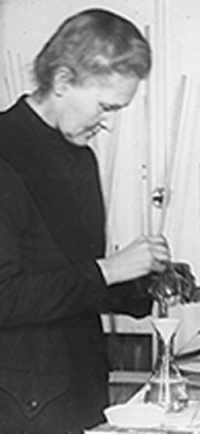Copyright Michael D. Robbins 2005
Astro-Rayological
Interpretation & Charts
Quotes
Biography
Images and Physiognomic Interpretation
All my life through, the new sights of Nature made me rejoice like a child.
Be less curious about people and more curious about ideas.
I am one of those who think like Nobel, that humanity will draw more good than evil from new discoveries.
I was taught that the way of progress is neither swift nor easy.
(Capricorn Ascendant)Life is not easy for any of us. But what of that? We must have perseverance and above all confidence in ourselves. We must believe that we are gifted for something and that this thing must be attained.
Nothing in life is to be feared. It is only to be understood.
One never notices what has been done; one can only see what remains to be done.
You cannot hope to build a better world without improving the individuals. To that end each of us must work for his own improvement, and at the same time share a general responsibility for all humanity, our particular duty being to aid those to whom we think we can be most useful.
(Stellium in Scorpio in 10th house)Humanity needs practical men, who get the most out of their work, and, without forgetting the general good, safeguard their own interests. But humanity also needs dreamers, for whom the disinterested development of an enterprise is so captivating that it becomes impossible for them to devote their care to their own material profit. Without doubt, these dreamers do not deserve wealth, because they do not desire it. Even so, a well-organized society should assure to such workers the efficient means of accomplishing their task, in a life freed from material care and freely consecrated to research.
(Pisces Moon. Capricorn Ascendant.)There are sadistic scientists who hurry to hunt down error instead of establishing the truth.
We must not forget that when radium was discovered no one knew that it would prove useful in hospitals. The work was one of pure science. And this is a proof that scientific work must not be considered from the point of view of the direct usefulness of it. It must be done for itself, for the beauty of science, and then there is always the chance that a scientific discovery may become like the radium a benefit for humanity.
I am among those who think that science has great beauty. A scientist in his laboratory is not only a technician: he is also a child placed before natural phenomena which impress him like a fairy tale.
“Nothing in life is to be feared, it is only to be understood. Now is the time to understand more, so that we may fear less.”
“I have no dress except the one I wear every day. If you are going to be kind enough to give me one, please let it be practical and dark so that I can put it on afterwards to go to the laboratory.”
“When one studies strongly radioactive substances special precautions must be taken. Dust, the air of the room, and one's clothes, all become radioactive.”
“I have frequently been questioned, especially by women, of how I could reconcile family life with a scientific career. Well, it has not been easy.”
“After all, science is essentially international, and it is only through lack of the historical sense that national qualities have been attributed to it.”
“It is my earnest desire that some of you should carry on this scientific work and keep for your ambition the determination to make a permanent contribution to science.”
“In science, we must be interested in things, not in persons.”
“We must act.”
“The various reasons we have just enumerated lead us to believe that the new radioactive substance contains a new element to which we propose to give the name of RADIUM.”
(Uranus conjunct Descendant in Cancer. Pluto opposition Scorpio Sun.)"My mother was 37 years old when I was born. When I was big enough to know her, she was already an aging woman who had reached the summit of renown. And yet it is the 'celebrated scientist' who is strangest to me - probably because the idea that she was a 'celebrated scientist' did not occupy the mind of Marie Curie. It seems to me rather, that I have always lived near the poor student, haunted by dreams, who was Marie Sklodowska long before I came into the world."
Eve Curie, biographer of her mother Albert Einstein once said of her:
"Marie Curie is, of all celebrated beings, the one whom fame has not corrupted."
Maria Sklodowska-Curie
Born November 7, 1867
Warsaw, Poland
Died July 4, 1934
Sancellemoz, FranceMarie Curie (Polish Maria Sklodowska-Curie, November 7, 1867 – July 4, 1934) was a Polish-French physicist and chemist. She was a pioneer in the early field of radioactivity, later becoming the first two-time Nobel laureate and the only person with Nobel Prizes in two different fields of science (physics and chemistry - due to the effects of sharing, she effectively obtained 1.25 Nobel Prizes). She also became the first woman appointed to teach at the Sorbonne. She was born a Pole in Warsaw, and spent her early years there, but in 1891 at age 24, moved to France to study science in Paris. She obtained all her higher degrees and conducted her scientific career there, and became a naturalized French citizen. She founded the Curie Institutes in Paris and in Warsaw.
Birthplace of Maria Sklodowska-Curie in Warsaw's "New Town."Born in Warsaw, Poland, then under the control of the Russian Empire, her early years were sad ones, marked by the death of her sister from typhus, and four years later, her mother. She was noted to have an amazing memory and a diligent work ethic, neglecting even food and sleep while studying. After graduating from high school at the top of her class at the age of fifteen, she was depleted of energy and was sent to the countryside to recover. Due to her gender and Russian (anti-Polish) reprisals following the January Uprising, she was not allowed admission to any university, so she worked as a governess for several years and attended the illegal Flying University. Eventually, with the monetary assistance of her elder sister Bronia, she moved to Paris. She went to high school at the Collège Sévigné, and then studied physics and mathematics at the Sorbonne, later becoming the first woman to teach there.
At the Sorbonne, she met and married another instructor, Pierre Curie. Together they studied radioactive materials, particularly the uranium pitchblende ore, which had the curious property of being more radioactive than the uranium extracted from it. By 1898 they deduced a logical explanation: that the pitchblende contained traces of some unknown radioactive component which was far more radioactive than uranium; thus on December 26th Marie Curie announced the existence of this new substance.
Over several years of unceasing labour they refined several tons of pitchblende, progressively concentrating the radioactive components, and eventually isolating the chloride salts (refining radium chloride on April 20, 1902) and then two new chemical elements. The first they named polonium after Marie's native country Poland, and the other was named radium from its intense radioactivity.
Maria Sklodowska Curie Nobel Prize DiplomaIn 1903 she became the first woman in France to complete her doctorate.Together with Pierre Curie and Henri Becquerel, she was awarded the Nobel Prize in Physics, 1903: "in recognition of the extraordinary services they have rendered by their joint researches on the radiation phenomena discovered by Professor Henri Becquerel". She was the first woman to be awarded a Nobel Prize. Eight years later, she received the Nobel Prize in Chemistry, 1911 "in recognition of her services to the advancement of chemistry by the discovery of the elements radium and polonium, by the isolation of radium and the study of the nature and compounds of this remarkable element". In an unusual move, Curie intentionally did not patent the radium isolation process, instead leaving it open so the scientific community could research unhindered. Just one month after accepting her 1911 Nobel Prize, Marie was hospitalized with depression and kidney trouble. Whenever Marie was feeling especially depressed she took a trip to the country to relax.
She was the first person to win or share two Nobel Prizes. She is one of only two people who has been awarded a Nobel Prize in two different fields, the other being Linus Pauling. As of June 2006, she remains the only woman to win two Nobel prizes.
Dolega Coat of ArmsAfter her husband's death from a street accident, she supposedly had an affair with physicist Paul Langevin, a married man who had left his wife, which resulted in a press scandal, exacerbated by her academic opponents in order to damage her credibility. Despite her fame as an honored scientist working for France, the public's attitude to the scandal tended towards xenophobia — she was a foreigner, from an unknown land (Poland was still referred to as a geographical area, under the Russian Tsar), an area known to have a significant Jewish population (Marie was raised as a Catholic, and was born in a gentry family [ Dolega-Sklodowski], but she later became an atheist). France at the time was still reeling from the effects of the Dreyfus affair etc, so the scandal's effect on the public was all the more acute. It is a strange coincidence that Paul's grandson Michel later married her granddaughter Hélène Langevin-Joliot.
During World War I, she pushed for the use of mobile radiography units, named "Little Curies" (or "petites Curies"), for the treatment of wounded soldiers. These units were powered using tubes of radium emanation, a colorless, radioactive gas given off by radium, later to be identified as radon. Marie personally provided the tubes, derived from the radium she purified. Promptly after the war started, she donated her and her husband's gold Nobel Prize Medals for the war effort.
In 1921, she toured the United States, where she was welcomed triumphantly, to raise funds for research on radium.
In her later years, she was disappointed by the myriad of physicians and makers of cosmetics who used radioactive material without precautions.
Plate commemorating Marie Sklodowska-Curie's first scientific endeavors in Ulica Krakowskie Przedmiescie in Warsaw.Her death near Sallanches in 1934 was from aplastic anemia, almost certainly due to her massive exposure to radiation in her work, much of which was carried out in a shed with no proper safety measures being taken, as the damaging effects of hard radiation were not generally understood at that time. She was known to carry test tubes full of radioactive isotopes in her pocket, and to store them in her desk drawer, resulting in massive exposure to radiation. She was known to remark on the pretty blue-green light the metals gave off in the dark.
At first, she was buried at the same cemetery in Sceaux where Pierre lay, but in 1995 their ash was transferred to the Panthéon to honour their works.
Her eldest daughter, Irène Joliot-Curie, won a Nobel Prize for Chemistry in 1935.
Her younger daughter Eve Curie wrote the biography Madame Curie after Marie's death.
In 1995, Madame Curie was the first and only woman laid to rest under the famous dome of The Panthéon in Paris on her own merits (alongside her husband Pierre Curie).
There is a 1943 U. S. Oscar-nominated film based on her life.
An extremely ahistorical Marie (Manya or Manyusya as it was when she was born) Curie appears as a character in the 1988 comedy Young Einstein by Yahoo Serious.
French playwright Jean-Noël Fenwick's 1989 lighthearted drama, "Les Palmes de M. Schutz," is based on the early romance and scientific collaboration of Marie and Pierre Curie. A 1997 movie version starred Isabelle Hupert as Mme. Curie.
Curie's picture was on the Polish inflationary late-1980s 20,000-zloty banknote. Her picture also appeared on the last French 500 franc note (with her husband Pierre Curie), and on stamps and coins.
Element 96 Curium (Cm) was named in honour of her and Pierre.
